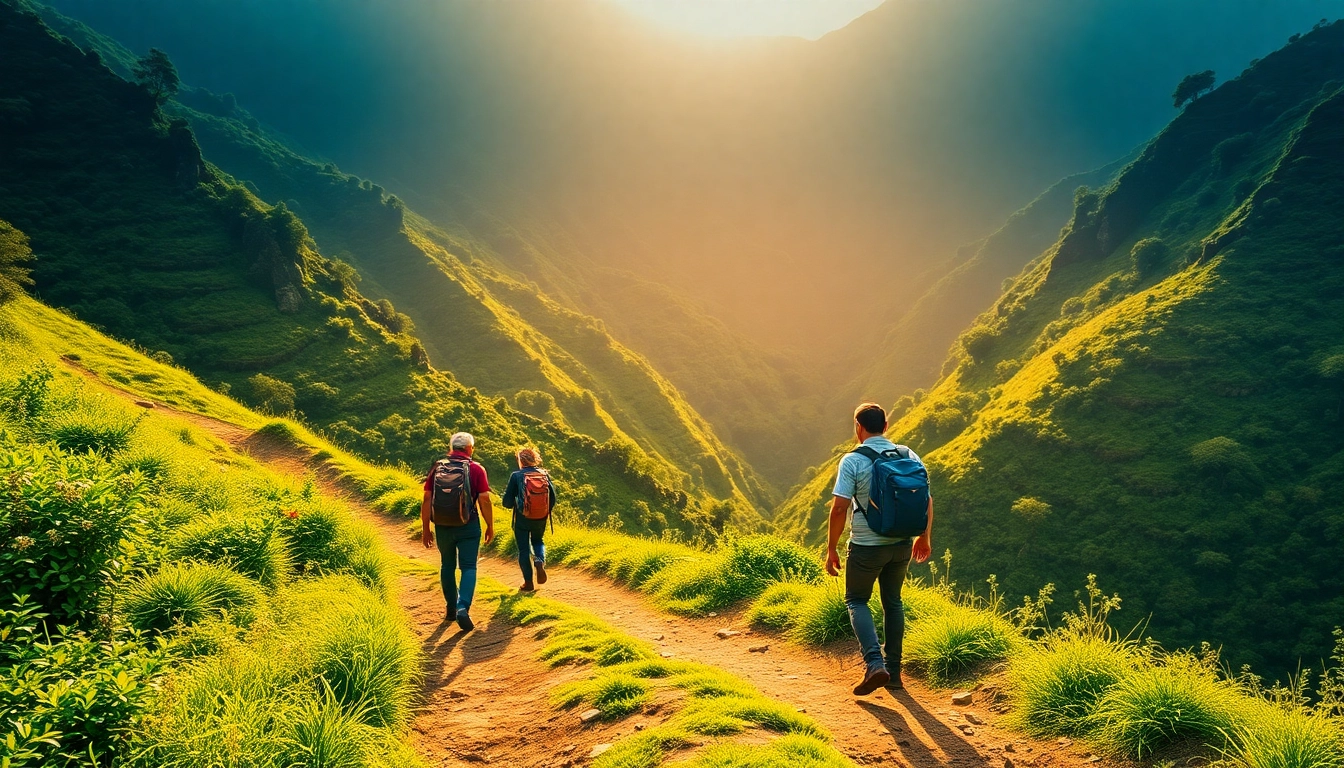Understanding Hiking: Definition, Types, and Variations in Indonesia
Hiking is more than just a leisurely walk; it is an immersive outdoor activity that combines physical exercise with the opportunity to explore nature’s diverse landscapes. In Indonesia, renowned for its rich biodiversity and stunning terrains, hiking has become a popular way for locals and tourists alike to connect with the environment, promote health, and experience cultural richness. At its core, hiking involves traversing trails on foot, often in natural settings such as forests, mountains, and coastal regions, with varying levels of difficulty and purpose.
To fully appreciate hiking’s significance, it’s essential to distinguish it from related activities like trekking and backpacking. For example, while hiking generally refers to shorter, less strenuous walks on defined paths, trekking involves multi-day journeys in remote and rugged terrain that demand greater planning and endurance. As Indonesia offers myriad terrains suitable for both, understanding these differences helps enthusiasts select suitable adventures and prepare adequately.
For those eager to explore Indonesia’s scenic trails, a comprehensive guide on hiking can provide valuable insights into different trail types, preparation techniques, and safety measures. Whether you’re a beginner seeking a gentle trail or an experienced hiker aiming for challenging summits, Indonesia’s diverse topography caters to all levels of outdoor enthusiasts.
The significance of hiking extends beyond physical health; it promotes mental well-being by reducing stress and fostering mindfulness amidst nature. Additionally, it offers avenues to engage with local cultures and support conservation efforts, making hiking a holistic activity that benefits individuals and communities. To explore more about the benefits and practical aspects of hiking, visit our dedicated hiking resource page.
1. Understanding Hiking: Definition, Types, and Variations in Indonesia
What Is Hiking and How Is It Different from Trekking?
Hiking is traditionally defined as a long, vigorous walk in natural environments, usually along a trail or footpath. It emphasizes enjoyment, exploration, and physical activity without necessarily demanding extensive planning or specialized equipment. In essence, hiking offers an accessible entry into outdoor recreation, suitable for individuals of varying ages and fitness levels. The activity often involves traversing trails in parks, forests, or mountain regions, providing a chance to witness scenic vistas and enjoy the tranquility of nature.
Contrastingly, trekking is a more intensive form of outdoor activity, often involving multi-day journeys through remote or rugged terrains. Trekkers typically carry their own gear, including camping equipment, food, and water, and navigate more challenging routes that may require technical skills. In Indonesia, while trekking might involve expeditions in isolated highlands or volcanic regions, hiking generally refers to day trips in accessible spots such as national parks or coastal trails.
An understanding of these distinctions aids enthusiasts in selecting appropriate adventures. For example, beginners might start with easier hikes in Lombok’s forests or beaches, whereas experienced explorers can challenge themselves with multi-day treks to volcanoes like Rinjani or in national parks like Ujung Kulon.
Types of Hiking Trails Popular in Indonesia
Indonesia’s vast archipelago offers an array of hiking trail types, each with distinct characteristics:
- Mountain Trails: Rinjani, the second-highest volcano in Indonesia, features multi-day hikes that reward climbers with panoramic vistas. Mount Bromo’s trails offer easier, yet dramatic, sunrise walks.
- Rainforest Trails: The rainforests of Sumatra and Kalimantan provide opportunities for jungle trekking, spotting wildlife like orangutans, and discovering dense flora.
- Coastal Trails: Trails along Bali’s beaches or Lombok’s coastline combine scenic ocean views with cultural visits, such as local villages or temples.
- Park Trails: National parks like Ujung Kulon and Komodo National Park feature well-maintained pathways suitable for all levels, emphasizing conservation and wildlife viewing.
Choosing the Right Hiking Adventure for Beginners and Experts
Selecting an appropriate trail depends on your fitness level, experience, and desired challenge. Beginners should focus on shorter, flat or gently inclined paths in accessible areas like Bali’s Sekumpul Waterfall trail or Lombok’s Sendang Gile Waterfall. These routes provide a good starting point to familiarize oneself with basic hiking techniques, safety, and gear.
Experienced hikers seeking adventure can explore Indonesia’s more demanding trails, such as the Rinjani Summit or the remote trails in the Baliem Valley. These routes require adequate preparation, including physical training, detailed planning, and proper gear. Regardless of your skill level, starting with guided hikes can enhance safety and learning.
For newcomers, following expert tips on pacing, hydration, and navigation can make hiking safe and enjoyable. For seasoned adventurers, focusing on route planning and environmental preservation ensures sustainable exploration.
2. Preparing for a Hiking Trip: Equipment, Safety, and Planning
Essential Hiking Gear and Clothing for Indonesia’s Terrain
Proper equipment is crucial for an enjoyable and safe hiking experience. In Indonesia’s diverse environments—from humid rainforests to volcanic terrains—gear needs to be versatile and suited to the conditions. Essential items include:
- Footwear: Durable hiking boots with good ankle support and waterproof features are recommended, especially for rocky or muddy trails. Lightweight trail shoes may suffice for easier routes.
- Clothing: moisture-wicking and quick-drying layers are vital, along with waterproof jackets and hats for sun and rain protection. Neutral colors help blend in with natural surroundings.
- Backpack: A comfortable, well-fitted pack with enough capacity for water, snacks, clothing, and safety essentials.
- Navigation Tools: Maps, GPS devices, or smartphone apps designed for outdoor use, combined with a compass.
- Safety Equipment: First aid kit, whistle, multi-tool, and personal identification. In remote areas, carrying a satellite communicator can be lifesaving.
Health and Safety Tips Before and During the Hike
Prior to embarking, ensure your health is suitable for physical exertion; consult a healthcare professional if needed. Adequate hydration, nutrition, and acclimatization to local climate conditions are vital. During hikes:
- Start with warm-up exercises to prevent injury.
- Maintain a steady pace to conserve energy.
- Stay hydrated and carry sufficient water, especially in hot and humid areas.
- Be aware of fatigue signs and rest as needed.
- Respect local wildlife and avoid disturbing natural habitats.
- Adhere to trail rules and guidance, especially in protected areas.
Additionally, inform someone about your route and expected return time. In remote areas, carrying a satellite phone or emergency beacon increases safety.
Planning Your Route: Maps, Permits, and Weather Considerations
Effective planning involves selecting suitable trails, obtaining necessary permits, and understanding weather patterns. Indonesia’s tropical climate can lead to sudden rainstorms and high humidity; thus, checking weather forecasts before departure is critical.
Use detailed maps or digital apps to outline your route, and confirm if permits are required, especially for protected areas or national parks. Many parks, such as Komodo or Rinjani, have specific entry requirements to protect ecosystems.
Planning should include consideration of the best seasons—dry season (April to October) generally offers better hiking conditions. Always have contingency plans and be flexible with your schedule to accommodate weather changes.
3. Top Hiking Destinations in Indonesia to Elevate Your Experience
Most Scenic Trails in Lombok and Surroundings
Lombok boasts a wealth of stunning trails that cater to all levels. The Mount Rinjani trek is Indonesia’s premier multi-day hike, offering breathtaking crater views, waterfalls, and hot springs. The trail to Sendang Gile Waterfall is a shorter, accessible option, perfect for beginners seeking natural beauty close to the island’s cultural villages.
Another popular route includes the Tiu Teja and Pass Trek, where trekkers enjoy panoramic vistas of the Gili Islands and the neighboring Bali. These trails combine physical challenge with ample opportunities for photography and cultural immersion.
Guided Hikes and Independent Adventures in National Parks
National parks like Ujung Kulon, Gunung Leuser, and Komodo are excellent for wildlife viewing and conservation-based hikes. Guided tours are highly recommended in these protected areas, as they ensure sustainable tourism and enrich your experience with expert knowledge about local flora and fauna.
Independent hikes are feasible in well-maintained parks like Bali’s Mount Batur, where trails are accessible and popular among tourists. Whether choosing guided or solo expeditions, always adhere to park regulations to safeguard ecosystems.
Best Seasons and Times to Hike in Indonesia
The dry season, from April to October, offers the most favorable weather for hiking across Indonesia. During these months, trails are less muddy, and skies are clearer—ideal for scenic views and outdoor activities. However, some high-altitude hikes, such as Rinjani, can be undertaken year-round, provided you prepare for temperature variations and weather fluctuations.
The rainy season (November to March) can be challenging, with muddy trails, reduced visibility, and increased risks. Nonetheless, lush landscapes and fewer crowds make certain hikes attractive during this period for experienced adventurers.
4. Benefits of Hiking: Physical, Mental, and Cultural Benefits
Enhancing Physical Fitness and Endurance
Regular hiking improves cardiovascular health, strengthens muscles, and enhances endurance. The activity involves various muscle groups, from leg and core muscles to upper body strength when using trekking poles. In Indonesia’s diverse terrains—steep inclines, uneven paths, and variable weather—hiking provides a comprehensive workout that boosts overall fitness.
Studies have shown that consistent outdoor activity can reduce the risk of chronic illnesses like hypertension, obesity, and diabetes. Moreover, hiking encourages active lifestyles and fosters positive behavioral habits.
Mental Health and Stress Relief Through Nature
Hiking in natural surroundings significantly reduces stress, anxiety, and depression. The tranquility of Indonesia’s lush forests, serene lakes, and mountain vistas fosters mindfulness and mental clarity. Scientific research indicates that exposure to nature during outdoor activities like hiking can lower cortisol levels, improve mood, and enhance cognitive function.
Many hikers also report a sense of achievement and self-confidence after completing challenging routes, which positively impacts mental resilience.
Connecting with Local Cultures and Conservation Efforts
Hiking often leads to interactions with local communities, offering insights into indigenous cultures, traditional crafts, and lifestyles. Trails near villages in Bali, Lombok, and Sumatra provide authentic cultural experiences that deepen appreciation for Indonesia’s diverse heritage.
Furthermore, responsible hiking supports conservation initiatives by fostering awareness and local economies rooted in sustainable tourism. Participating in eco-friendly hikes and following Leave No Trace principles help preserve Indonesia’s natural beauty for future generations.
5. Tips for Beginners and How to Improve Your Hiking Skills
Starting Small and Building Endurance
For beginners, the key to success is gradual progression. Initiate with short trails, such as local parks or easy forest walks, focusing on proper footwear and pacing. As endurance improves, progressively take on longer or steeper routes.
Consistent training, including cardio exercises like cycling or swimming, enhances stamina. Learning to listen to your body and avoiding overexertion prevents injuries and discouragement.
Maintaining Nutrition and Hydration During Hikes
Proper nutrition sustains energy on the trail. Pack lightweight, nutrient-dense snacks such as nuts, dried fruits, or energy bars. Hydration is equally vital; carry sufficient water and consider using hydration packs or portable water filters when venturing into remote areas.
Recognize signs of dehydration and fatigue early; taking regular breaks and replenishing fluids helps maintain performance and enjoyment.
Safety Tips for Solo and Group Hikes
Safety considerations differ between solo and group hikes. Solo hikers should inform someone of their itinerary, carry emergency communication devices, and stay on marked trails. In group settings, establish clear roles, communicate plans, and keep an eye on environmental conditions.
Equip yourself with basic first aid knowledge, and prioritize environmental preservation by following designated paths and waste disposal rules. Always respect local customs and obtain necessary permits when hiking in protected areas.



